 Download PDF
Download PDF
Name: Rosa setigera Michx.
Family: Rosaceae (the Rose family)
Common Names: Prairie Rose, Climbing Rose, Climbing Prairie Rose, Prärie-Rose
Etymology: Rosa comes from the ancient Latin word rosa whose meaning has been lost. Setigera is a compound of two Latin words: seti meaning “bristle” and gero meaning “bearing”, therefore setigera means “bristle-bearing” (12).
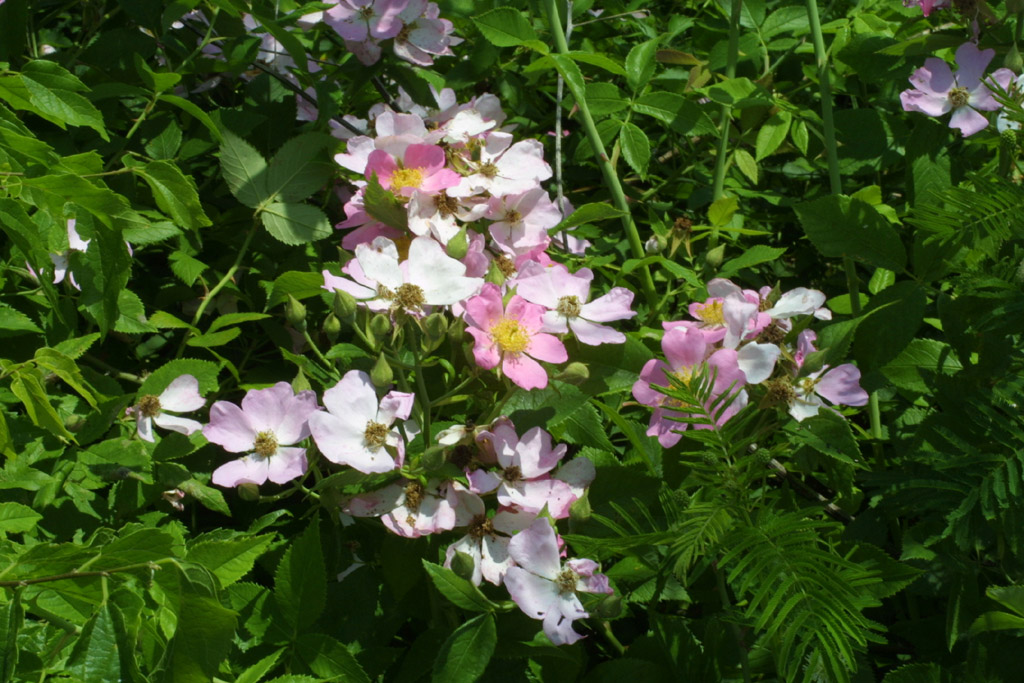 Botanical synonyms (14):
Botanical synonyms (14):
Rosa rubifolia R. Brown
Rosa fenestrata Donn ex Trattinnick
Quick Notable Features:
¬ prickles recurved and flattened at the base
¬ flowers pink, showy, in dense mounds
¬ trailing or climbing by arching its stems
¬ stipules adnate more than half their length to petiole, without a fringe at margin
Plant Height: 2-4m in length (2, 15)
Subspecies/varieties recognized (2, 5):
R. setigera Michx. var. setigera,
R. setigera Michx. var. tormentosa Torr & Gray
R. setigera var. serena
Most Likely Confused with: other species in the genus Rosa that overlap its range, such as Rosa multiflora, Rosa laevigata, and potentially bristly members of the genus Rubus, the blackberries and raspberries.
Habitat Preference: Woods, thickets, fencerows, pastures, roadsides, and occasionally found in wetlands and along streams (1, 2, 5, 7, 8, 15). In Florida, it is suggested that it prefers upland environments (14).
Geographic Distribution in Michigan: Found in the southern counties: Berrien, Cass, Hillsdale, Kalamazoo, Lenawee, Monroe, Oakland, Wayne, Washtenaw, Jackson, and Macomb, and only in the northern Michigan county of Manson (1, 2).
Known Elevational Distribution: No specific information for this species was found, but gardening websites suggest it is hardy to Zone 4, and grows in the city of Denver, CO, suggesting it can tolerate an elevation of 1000m.
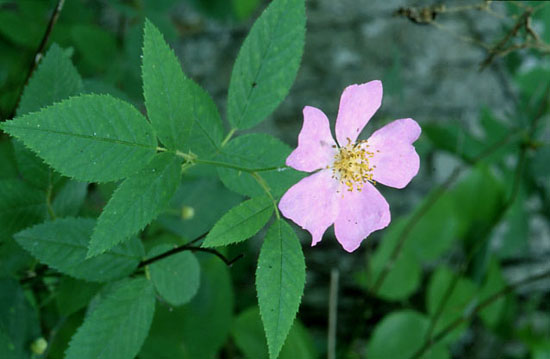 Complete Geographic Distribution: Native to the continental United States. Distribution is widespread throughout the northeast, southeast, north central, central and southern plains of the United States (5). It is also found in southwestern Ontario (2).
Complete Geographic Distribution: Native to the continental United States. Distribution is widespread throughout the northeast, southeast, north central, central and southern plains of the United States (5). It is also found in southwestern Ontario (2).
Vegetative Plant Description: The long stems are glabrous, arching or trailing. The plants are capable of producing clones by rerooting at arching tips that contact the soil. They have thick, prickles, that are either straight or slightly curved, but often flattened at the base. Leaves are palmately divided with three (to five rarely) serrate-margined leaflets (2-7cm long and 1-4cm wide). The terminal leaflet generally has a longer petiolule. Stipules are present, narrow, and either entire or with a finely toothed margin. They can also be glandular or ciliate on their surfaces and margin and are adnate to the petiole for more than half their length (7, 15, 16). The ovate to ovate-oblong eaflets vary from glabrous to tomentose (especially along the veins below) within the currently recognized species (16, 21).
Climbing Mechanism: a trailing or scrambling vine, which uses only the recurved prickles for attachment (pers.obs.).
Flower Description: Inflorescences corymbose, often with leafy bracts below the flowers. Flowers 4-8cm across with five pointed, reflexed, deciduous sepals, five petals that are pink and 2-3cm long, stamens numerous, carpels numerous with styles united into a column half as long as the stamens or as long as the stamens. The pedicels, hypanthium, and sepals bear stipitate glands (15,16, 21). The plants are functionally dioecious, with only male or female organs functional in a single plant (19).
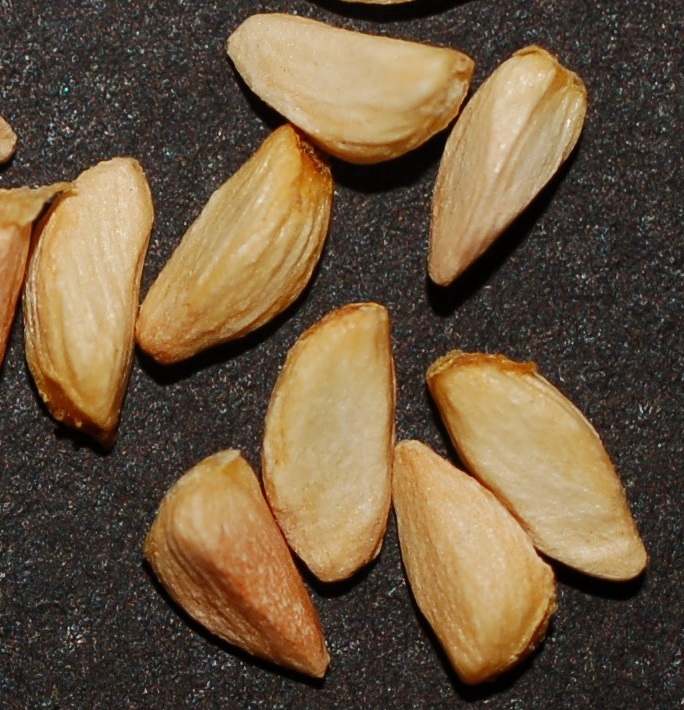 Flowering Time: Illinois: early to mid-summer, Canada: late June to mid-July, reported as “May to October” in the southeastern U.S. (11,15, 19).
Flowering Time: Illinois: early to mid-summer, Canada: late June to mid-July, reported as “May to October” in the southeastern U.S. (11,15, 19).
Pollinator: A wide variety of flying pollinators from the families Andrenidae, Apidae (mainly Apis mellifera), Halictidae, Megachilidae, Syrphidae (mainly Eristalis tenax), and the genus Xylocopa (10). Also pollinated by one beetle: Trichiotinus piger (11).
Fruit Type and Description: an aggregate of achenes enclosed in a fleshy “hip” derived from the hypanthium of the flower. This hip is red at maturity, globose, about 1cm in diameter. The fruit maintains the stipitate glands from the young ovary (15). The fruits are eaten, and the seeds likely dispersed, by small mammals and birds, including the Greater Prairie Chicken and Bob White Quail (18).
Seed Description: Crescent-shaped to oval achenes with a triangular cross-section. Multiple achenes, which measure 3-4 mm, are enclosed in a fleshy hip (6, 7).
Dispersal Syndrome: The fleshy hip certainly suggests dispersal by animals, and the fruits are attractive. as noted above, to a variety of animals. Rose hips are high in vitamin C, by some sources, as much as 14.6% of the dried pulp is vitamin C (17).
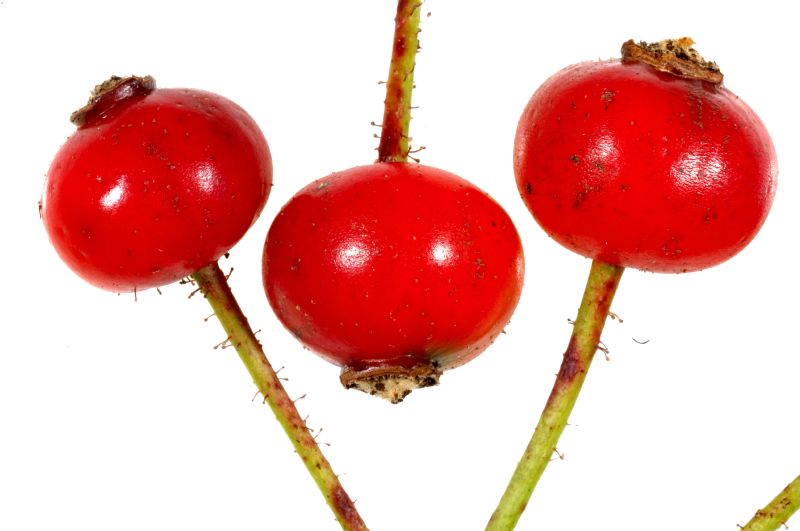 Distinguished by: R. setigera is distinguished from R. laevigata by flower color and stipule adnation: R. laevigata has white flowers and the stipules are free from the petiole for more than half their length. It is distinguished from R. multiflora also by the stipules, but this time R. multiflora has distinctly fringed stipules. Rosa palustris (Swamp Rose) is an upright shrub, rather than a climber. A simple way to distinguish raspberries and blackberries (Rubus) from roses (Rosa) is that the genus Rubus will never have stipules fused to the petioles.
Distinguished by: R. setigera is distinguished from R. laevigata by flower color and stipule adnation: R. laevigata has white flowers and the stipules are free from the petiole for more than half their length. It is distinguished from R. multiflora also by the stipules, but this time R. multiflora has distinctly fringed stipules. Rosa palustris (Swamp Rose) is an upright shrub, rather than a climber. A simple way to distinguish raspberries and blackberries (Rubus) from roses (Rosa) is that the genus Rubus will never have stipules fused to the petioles.
Other members of the family in Michigan (number species): Agrimonia (5), Amelanchier (6), Aronia (1), Aruncus (1), Chamaerhodos (1), Crataegus (45), Dalibarda (1), Duchesnea (1), Filipendula (1), Fragaria (2), Geum (9), Malus (3), Physocarpus (1), Porteranthus (2), Potentilla (14), Prunus (15), Pyrus (1), Rosa (14), Rubus (13), Sanguisorba (2), Sorbaria (1), Sorbus (3), Spirea (5), Waldsteinia (1). (source: 1)
Ethnobotanical Uses: Although no ethnobotanical data was found for Rosa setigera, a similar species, Rosa blanda has many medicinal uses. The roots, when ground up and boiled, make a paste that alleviates skin irritation. A wash for irritated eyes and a treatment of headache or lower back pain are also made from the roots. The skin of the rose hips is used to aid with stomach pain and digestion problems. The dried flowers are a suppressor of heartburn (9).
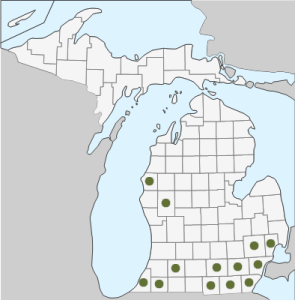 Phylogenetic Information: Rosaceae members are found in almost every inhabitable part of the world (16). Within this large family, Rosa is in the subfamily Rosoideae. Rosaceae belongs in the order Rosales, and is closely related to Ulmaceae, the elm family. Rosales are classified as members of the Eurosids I subclade in the Rosid clade. Rosids are core eudicots (14).
Phylogenetic Information: Rosaceae members are found in almost every inhabitable part of the world (16). Within this large family, Rosa is in the subfamily Rosoideae. Rosaceae belongs in the order Rosales, and is closely related to Ulmaceae, the elm family. Rosales are classified as members of the Eurosids I subclade in the Rosid clade. Rosids are core eudicots (14).
Interesting Quotation or Other Interesting Factoid not inserted above:
Rosa setigera is a cryptically dioecious dicot: although both male and female parts are made in every flower, the pollen of female flowers is collapsed and pollinators tend to spend more time foraging on the male flowers (which tend to be in larger numbers in male inflorescences). The plant’s sex is very hard for the observer to determine, apart from these subtle considerations (10).
Rosa setigera is listed as a threatened plant in Canada (19).
Rose hips have been widely evaluated for their vitamin C content, and in the 1940’s independent reports from Britain and the former Soviet Union demonstrated that at higher latitudes, rose hips of various Rosa species had higher vitamin C content (17).
Literature and websites used:
- Voss, E.G. 1985. Michigan Flora Part II. Ann Arbor: University of Michigan Press.
- Gleason, H.A. & A. Cronquist 1963. Illustrated Flora of Northeastern United States and Canada. New York, New York: Hafner Publishing Company, Inc.
- Young, J.A. & C.G. Young 1992. Seeds of Woody Plants in North America. Portland, Oregon, USA: Dioscorides Press.
- Parkhurst, H.E. 1903. Trees, Shrubs and Vines of the Northeastern United States. New York, New York, USA: Trow Directory Printing and Bookbinding Company.
- USDA Natural Resources Conservation Plants Database. http://plants.usda.gov/index.html.
- Campbell, C.S., W.S. Judd, E.A. Kellogg, & P.F. Stevens 1999. Plant Systematics: A Phylogenetic Approach. Sunderland, Massachusetts, USA: Sinauer Associates, Inc.
- Radford, A.E., H.E. Ahles, & C.R. Bell 1968. Manual of the Vascular Flora of the Carolinas. Chapel Hill, North Carolina, USA: The University of North Carolina Press.
- Missouri Botanical Garden. http://www.mobot.org/default.asp
- Moerman, D. Native American Ethnobotany Database. http://herb.umd.umich.edu
- Kevan, P.G., D. Eisikowitch, J.D. Ambrose, & J.R. Kemp. 1990. Cryptic dioecy and insect pollination in Rosa setigera Michx. (Rosaceae), a rare plant of carolinian Canada. Biological Journal of the Linnean Society 40(3):229-243.
- Hilty, J., Insect Visitors to Illinois Wildflowers. Last updated: 2006. Illinois Wildflowers Pollination. http://www.shout.net/~jhilty/
- Charters, M.L., Latin and Greek Meanings and Derivatives. http://www.etymologie.info/~e/u_/us-__ca__.html
- Native Plant Data Base, Lady Bird Johnson Wildflower Center 2010. http://www.wildflower.org/plants/result.php?id_plant=rose2
- Wunderlin, R.P. & B.F. Hansen 2008. Atlas of Florida Vascular Plants. Institute for Systematic Botany, University of South Florida, Tampa. http://www.plantatlas.usf.edu/
- Foote, L.E., & S.B. Jones Jr. 1989. Native Shrubs and Woody Vines of the Southeast: Landscaping Uses and Identification. Portland, Oregon, USA: Timber Press.
- Gleason, H.A. 1963. The New Britton and Brown Illustrated Flora of the Northeastern United States and Adjacent Canada, Volume 2. New York, New York: Hafner Publishing Co., Inc.
- Pyke, M. & R. Melville 1942. Vitamin C in rose hips. Biochem J. 36(3-4): 336–339.
- Shaw Nature Reserve 2010. Species-specific accounts accessed 9-28-2010 at http://www.shawnature.org/default.aspx.
- COSEWIC 2002. COSEWIC assessment and update status on report on the climbing prairie rose Rosa setigera in Canada. Committee on the Status of Endangered Wildlife in Canada. Ottawa.
- MICHIGAN FLORA ONLINE. A. A. Reznicek, E. G. Voss, & B. S. Walters. February 2011. University of Michigan. Web. December 19, 2012. http://michiganflora.net/species.aspx?id=2547
- Fernald, M. L. 1950. Gray’s Manual of Botany, 8th ed. New York: American Book Company.
Image Credits (all used with permission):
1) Flower image is courtesy of (c) 2002 Steve Baskauf, downloaded from Bioimages at http://bioimages.vanderbilt.edu/
2) Flower/leaf image is courtesy of Dr. Dennis D. Horn from the Tennessee Vascular Plants Atlas, University of Tennessee Herbarium and Austin Peay State University http://tenn.bio.utk.edu/vascular/vascular.shtml
3) Seed image is © Robyn J. Burnham, University of Michigan, Ann Arbor, MI USA
4) Fruit image is courtesy of Dr. B. Eugene Wofford from the Tennessee Vascular Plants Atlas, University of Tennessee Herbarium and Austin Peay State University http://tenn.bio.utk.edu/vascular/vascular.shtml
5) Species distribution map, derived from the Michigan Flora Online.
Primary Authors: Marko Melymuka, John Bradtke, and Robyn J. Burnham contributed to this account.
© Robyn J. Burnham, University of Michigan
For additional information on Michigan Plant Diversity web pages please contact Robyn J. Burnham via email: rburnham“at”umich.edu